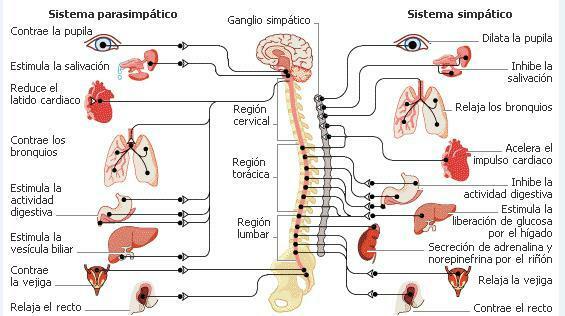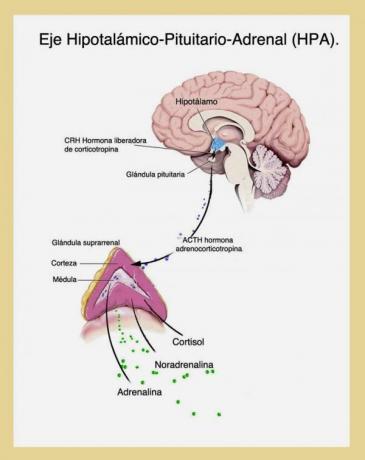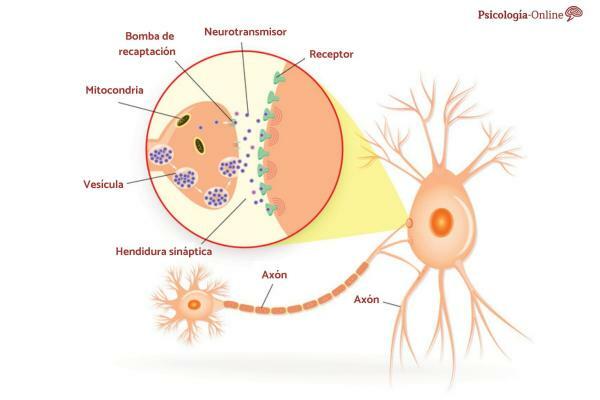
The changing circumstances of the environment and throughout life, demand a constant exercise of adaptation to the environment that have different repercussions on people. Individuals try to achieve a balance between the benefits and the costs that such adaptation implies, in situations that cause us discomfort. This process, different in each subject, is carried out both internally and externally. And stress would only be the first sign of reaction to an alarm triggered by a threat that we are detecting (at the nervous level in the amygdala). In this Psychology-Online article we will see how stress affects the nervous system.
Index
- The stress reaction
- The phases of stress
- The stress response in the autonomic nervous system
- Effects of stress on the brain
- Effects of stress on the nervous system
- Consequences of chronic stress
- Prolonged stress: some effects on the hippocampus and its functions
- Effects of prolonged stress on the prefrontal cortex and its functions
- Effects of chronic stress on the amygdala and its functions
- Summary of the effect of stress on the nervous system
The stress reaction.
The stress is defined as a particular reaction between the demands of a situation and coping resources available to a person, where a relationship is established between both factors. Stress is a psychological process that is activated when a change in environmental conditions and its function is to prepare the organism to give an adequate response to such changes (Fernández Abascal, E., et als., 2010). The individual values how the demand exceeds his capacity to face it (Steptoe & Ayers, 2005) or he estimates what you can do to achieve your goals and if this is enough to overcome the obstacles present.
The physiological response to stress involves complex and dynamic feedback mechanisms between the neuroendocrine, cardiovascular, metabolic and immune systems (McEwen & Karatsoreos, 2012; McEwen & Seeman, 1999). All of them prepare the person to face the situation by escaping, facing it or inhibiting himself and remaining blocked or unproductive.
Internally, there is a reaction that involves a neurobiological network that acts in the detection of the stimuli that trigger stress.
The phases of stress.
The threatening situation that generates stress can be specific or can be prolonged in time. In this second case, an escalating reaction occurs in which the body will try to get the maximum energy.
- It goes from one initial alarm phase, when the presence of the stressor is detected.
- If it persists, it would pass to a second adaptation or resistance phase, during which the subject's body offers a range of responses that try to seek balance or homeostasis (the one in which we find ourselves usually, under normal conditions) in a process called allostasis (endogenous processes triggered to maintain stability through change suffered). It is a fundamental process by which the body actively adjusts to predictable and unpredictable events. It allows to seek a dynamic balance.
- If it is prolonged, the body enters a third phase of exhaustion and, this is when alterations and pathologies related to the chronic stress.
The stress response in the autonomic nervous system.
The response to stress has a lot to do with the nervous system of vertebrates, specifically with the autonomic nervous system. In the face of a perceived threat, part of this system is activated and part is inhibited.
Sympathetic nervous system
The part that is activated is the sympathetic nervous system. Its origin is in the brain, but its projections radiate from the spinal cord and contact almost every organ, blood vessel, and sweat gland in the body. This system is activated during what our brain considers an emergency. Modulates our activation, like a emergency system. Its activation increases:
- surveillance
- the motivation
- a general stimulation
When this system is activated, the hypothalamus triggers the acceleration of the adrenal glands, which release catecholamines: adrenaline and noradrenaline, which play an important role as neurotransmitters (those that interest us in this case). This is one rapid activation of the so-called SAM axis (Sympathetic-Adreno-Medullary).
Parasympathetic nervous system
The other half of the autonomic nervous system, the parasympathetic nervous system, which in this alarm process, to help the correct functioning of the first, is inhibited. This system mediates vegetative functions that promote growth and energy storage. In this network are the thalamus, the sensory cortex and the amygdala (which has triggered the entire alarm process). The activity of the latter is moderated by two influences inhibitory: the hippocampus and prefontal cortex.
- The hippocampus exerts an inhibitory control based on previous learning and memory.
- The prefrontal cortex does it based on executive functions, such as attention and meta-cognition.
Thus, the amygdala, hippocampus and cortex form a detection network for environmental threats (Danese et al., 2009).
In the following graph you can see both systems and the functions they perform, in a very summarized way.

Image: Encarta Encyclopedia, Microsoft Corporation (2009).
Effects of stress on the brain.
Simultaneously, stress increases the activity of other structures at the brain level, in preparation for future demands: that of the HPA (hypothalamic-pituitary-adrenal) axis, as shown in the graph below.
It allows you to solve stressful situations in the short term in the face of a threat through the following process:
- In the first instance, the hypothalamus secretes a hormone (corticotropin or CRH).
- This hormone stimulates the pituitary gland to release adrenocorticotropin (ACTH).
- This causes the adrenal glands to secrete three more types of hormones: adrenaline, norepinephrine, and cortisol.
- Adrenaline and norepinephrine they increase our blood pressure and heart rate, divert the blood supply from the gastrointestinal system to the muscles, and speed up reaction time.
- Cortisol releases sugar from physiological stores to provide immediate energy to the body. Cortisol serves, in the event of wounds or injuries, to prevent inflammation. Muscles receive a blood supply and extra fuel increasing our strength, the mind is activated and achieves greater concentration, in order to restore balance, homeostasis or seek the survival of the organism.

Image: EOS Clinic
Effects of stress on the nervous system.
Stress, be it positive (eustress) and negative (distress), increases the activity of the HPA axis, being able to cause opposite effects in the organism; well allowed an effective adaptation to new situations, also enhancing cognitive and the consolidation of memories that will allow the individual to anticipate future situations unpleasant. Although if the demands are exceeded, the physiological over-activity manages to restore homeostasis Without consequences for the health of the individual, it will have had consequences in future analogous situations. On the contrary, when the stress response is inadequate and the restoration of homeostasis is prevented, overactivity of the HPA axis can cause maladaptive effects, such as cognitive impairment or the development of various associated psychopathologies (Deppermann et al. 2001), some of which we will indicate below.
Consequences of chronic stress.
The elevated glucocorticoid levels in the bloodstream can cause adverse effects on the neuron physiology and its ramifications, even of a toxic nature for them, causing changes in the nervous system. Structural and functional changes caused by chronic stress in the brain lead to disorders in mood and in behavioral and physiological responses (Hroudová et als., 2010). Among the main adverse effects are:
- Inhibition of glucose uptake (energy source) by neurons, altering and stopping their growth.
- Increased neurotoxicity: the stress response triggers a biochemical cascade in the neuronal synapse, mainly in the hippocampus and prefrontal cortex, causing an overactivity that causes cytoskeletal degradation in neurons (support of the internal structure, transport of nutrients and other neuronal substances, trafficking and cell division) protein malformation and the generation of oxygen radicals, inducing atrophy and even the neuronal death.
- Decreased expression of biochemical factors in regions such as the hippocampus and prefrontal cortex and an increase in the amygdala (Deppermann et al. 2001). The hippocampus, the amygdala and the prefrontal cortex are structures prone to undergo remodeling, whose reversible potential or not, It will depend on the duration of the stressors and the neurochemicals that have been released, with effects not only at the cognitive level, but also influencing the emotional regulation, behavior and neuroendocrine functions of the organism (Radahmadi et als., 2014).
Prolonged stress: some effects on the hippocampus and its functions.
The hippocampus is one of the most sensitive brain structures and prone to remodeling, due to the high concentration of receptors for glucocorticoids it possesses, and the role it plays in learning, and in the consolidation and evocation of declarative memory (Finsterwald et al. als, 2014). It plays a structural role in the creation of new memories, consists of strengthening pre-existing neural connections, making them more excitable and enhancing them so that they can last (in the long term). Although it does not store memories, it fosters networks that allow associating previous experiences and activation patterns evocative of different memories, immediately.
Normal glucocorticoid levels facilitate hippocampal plasticity, long-term potentiation, and promote new structures (Gómez et als., 2006). In the short term, stress causes the arrival of more oxygen and glucose to the brain, thus increasing its level of activity and allowing for better long-term potentiation, making it easier to remember and store information. Nevertheless, if the stressor becomes chronic, glucose and oxygen levels decrease, atrophy and restructuring by hippocampal neurons begin to be seen, as well as inhibition in the processes of creating new connections, the individual suffering memory problems (at least in animal models (Ronzoli, 2017, corroborating previous studies by McEwen). Exposure to adverse conditions, in animals, eventually induces structural (dysfunction, atrophy and neuronal death) and functional damage (which produce the remodeling of their circuits, a general reduction in their volume, produced mainly by the toxic effects of the glucocorticoids. Some effects are reversible in the absence of the stressor.
Since it regulates the activity of the HPA axis and the consolidation of certain aspects of memory, its deterioration, the product of Chronic exposure to stressful situations can affect episodic, declarative, contextual and space, affecting the individual's ability to process information in new situations and make appropriate decisions. In addition, it affects the ability to alter the activity of the HPA axis, limiting it and prolonging the secretion of glucocorticoids into the bloodstream.
Effects of prolonged stress on the prefrontal cortex and its functions.
The prefrontal cortex presents a general reduction in size, product of structural and functional changes in neurons, related to prolonged exposure to glucocorticoids. However, while chronic stress produces a reduction in the dendritic spines of its medial cortex, in its orbito-frontal region, it shows their growth (McEwen et als., 2010). This difference interferes with the ability of the prefrontal cortex to terminate the physiological stress response, maintaining (by default) the activity of the HPA axis even in the absence of the stressor stimulus longer than necessary, increasing the harmful effects (Arnsten, 2009). These changes in synaptic connections result in a general decline in executive functions (deficit in decision-making, low emotional self-regulation and decreased attention focus) affecting the individual's coping skills. In addition, in animal models a decrease in the performance of working memory and in fear conditioning (through which threats present in the environment can be recognized environment).
In sum, this prolonged effect affects the neuronal relationship between the prefrontal cortex and the hippocampus, interfering in a correct consolidation of new memories (Arnsten, op. cit.).
Effects of chronic stress on the amygdala and its functions.
In the case of amygdala, stress increases your neuronal activity and connections with other regions of the brain. This fact causes them to revive in individuals heightened responses of aggressiveness, fear, and anxiety. As a consequence, it makes them more susceptible to more complex or more serious behavioral and emotional alterations (depression). These modifications are more durable in the aforementioned structures, with less reversibility or recovery, even in the absence of the stimulus (Pittenger et als., 2008).
Summary of the effect of stress on the nervous system.
In short and in a very summarized way, given the complexity of the structures involved, we can say that stress is a reaction that prepares the body for a threat, for Therefore, it has an adaptive nature, trying to create a state of alarm that favors survival and helps to face adversity situations that affect the individual. At optimal levels, it enables adaptation to various situations or threats, enhancing cognitive functions, making them manageable and preserving health.
To a high or prolonged degree over time, it can have a more lasting effect on neuronal structure and restructuring capacity of the same, greater in the case of the hippocampus, the amygdala or the cortex pre-frontal. In this case, the individual's coping capacities, altered, increased - with difficulty to recover the desirable balance -, the harmful effects are enhanced and indirectly perpetuated, having a negative effect and may promote disease onset and general deterioration of the organism.
Directly, as a consequence it has an important potential to cause alterations in the behavior of the subjects. It is important to highlight the variability of situations, the difference between individuals and the repercussions on their health, which can be seen modified by the cognitive evaluation that the individual performs and the socio-genetic-cultural baggage that he has acquired throughout his lifetime. It is convenient that when faced with circumstances that threaten survival or resistance capacity a specialist is called on. This will provide a individualized treatment, identifying the reactions of each subject in front of stressful stimuli and advising or promoting the form of face these situations, in order to be able to minimize the physiological effects and allow a better physical well-being and psychological.
This assistance will help you, as far as possible, to gain control over stress and its consequences. trying to seek the greatest benefits for the person and managing to reduce the deterioration to which the individuals. In the following article you will find information about how to work and reduce stress.
This article is merely informative, in Psychology-Online we do not have the power to make a diagnosis or recommend a treatment. We invite you to go to a psychologist to treat your particular case.
If you want to read more articles similar to How stress affects the nervous system, we recommend that you enter our category of Neuropsychology.
References
- Arnsten, A. (2009): Stress signaling pathways that impair prefrontal cortex structure and function, National Review of Neuroscience 10(6), 410–422.
- Danese, A., Moffitt, T. E., Harrington, H., Milne, B. J., Polanczyk, G., Pariante, C. M., Caspi, A., (2009): Adverse Childhood Experiences and Adult Risk Factors for Age-Related Disease. Depression, Inflammation, and Clustering of Metabolic Risk Markers. Archives of Pediatrics & Adolescent Medicine, 163 (12), pp. 1135-1143. Doi: Vbnm, 0.1001 / archpediatrics.2009.214
- Deppermann, S., Storchak, H., Fallgatter, A. J. and Ehlis, A. (2014): Stress-Induced Neuroplasticity: (mal) adaptation to adverse life events in patients with PTSD - a critical Overview. Neuroscience 283, 166-177.
- Fernández Abascal, E.; García Rodríguez, B.; Jiménez Sánchez, MªP.; Martín Díaz, MªD.; Domínguez Sánchez; F. (2010): Emotion psychology. Editorial Center for Studies Ramón Areces, Madrid, 2010.
- Fisterwald, C. and Alberini, C. M., (2014): Stress and glucocorticoid receptor-dependent mechanisms in long-term memory: From adaptive response to psychopathologies. Journal of Neuroscience, 2014, No. 112, 17-29.
- Gómez González, B.; Escobar, A. (2006): Stress and the immune system. Mexican Journal of Neuroscience, 2006; 7(1): 30-38
- Hroudová J. and Fisar Z. (2010): Common aspects of neuroplasticity, stress, mood disorders and mithochondrial functions. Activitas Nervosa Superior Rediviva 53(1), 3-20
Bibliography
- Mcewen, B. S. and Gianaros, P. J. (2010): Central role of the brain in stress and adaptation: Links to socioeconomic status, health, and disease. Annals of the New York Academy of Sciences, 1186 (The Biology of Disadvantage), 190–222. http://doi.org/10.1111/j.1749-6632.2009.05331.x.
- McEwen, B. S., & Karatsoreos, I. N., (2012): What Is Stress? In A. Chouker (Ed.), Stress Challenges and Immunity in Space, (pp. 11-29): Springer Berlin Heidelberg.
- McEwen, B. S., & Seeman, T., (1999): Protective and Damaging Effects of Mediators of Stress. Elaborating and Testing the Concepts of Allostasis and Allostasis Load. Annals of the New York Academy of Sciences, 896, 30 - 47.Doi: 10.1111 / j.1749-6632.1999.tb08103.x
- Pittenger, C. and Duman, R., (2008): Stress, Depression, and Neuroplasticity: A Convergence of Mechanisms. Neuropsychopharmacology Reviews 33: 88-109.
- Radahmadi, M., Housseini N. and Nasimi, A. (2014): Effect of chronic stress on short and long-term plasticity in dentate gyrus; study of recovery and adaptation. Elsevier Neuroscience, 2014, No. 280, 121-129.
- Ronzoli, G. (2017): Prefrontal cortex, amygdala and stress: study of norepinephrine, corticosterone and aversive memory in the rat. Doctoral thesis. Complutense University of Madrid, 2017.
- Steptoe, A., & Ayers, S., (2005): Stress, Health and Illness. In S. Sutton, A. Baum & M. Johnston (Eds.): The SAGE Handbook of Health Psychology, (pp. 169 -196). London: Sage.


